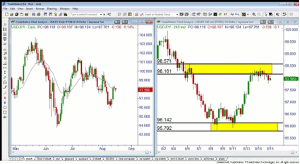Rick Wright of Online Trading Academy talks about trading plans, and specifically how his has changed over the last few months.
First of all, what is a trade plan? Well, it depends on who you ask. I define it as everything I plan on doing as a trader including: 1. Trade strategies, 2. Risk management rules, 3. Goals, 4. Record keeping requirements, 5. Whatever else applies to my trading life.
I know some will look at that short list and say that parts of it should be in your “business plan,” not the trade plan. That is fine, as long as you have your rules and regulations for your trading career written out in some way. I would like to briefly discuss the previous items on the list, then tell you how mine has changed.
Trade Strategies: In this section of your trading plan, you should define what trading techniques you plan to employ. I’ve found that one of the easier ways to do this is by taking screenshots of what you want to see to place a trade. This can be done easily by hitting the “Print Screen” button and pasting the image into a Word document, then typing a brief description of the setup. Here’s an example:
Strategy One Rules: Looking at a daily chart, I will look to enter trades when the candle has touched a 20-day moving average, provided that the price action on a four-hour chart is in a supply or demand zone with at least a score of six out of eight using my odds enhancers scale. My stop loss goes on the other side of the zone I am using to enter my trade, and my reward to risk ratio must be at least 3:1.
Using screenshots of the charts saves a lot of time typing in a description of what you are looking for! I would expect most traders to have at least two strategies for each market type-uptrend, downtrend, and sideways.
Risk Management: In every class I teach, I recommend extremely conservative rules for position sizing and dollar risk. The reason is simple—as you learn to trade, you want to take very small losses until trading is as natural as breathing. With small losses in the beginning, you will still have a trading account when you get good at this! If you take large losses in the beginning of your trading career, it may take years to get to the point of trading for a living. For example, I recommend risking 1/4-1/2% of your account on any particular trade. Another rule would be to risk no more than 3/4 to 1.5% of your account on any given day. Other rules: only take trades with at least 3:1 reward to risk ratios, don’t trade when an interest rate decision from a central bank is coming out, don’t have more than three positions on at a time, etc. etc.
NEXT PAGE: Good Record Keeping is Key
|pagebreak|Goals: As I have mentioned in previous articles, having long-term goals is a good way to keep yourself accountable and disciplined in your trading. Knowing that your career isn’t based on one trade but over (maybe) ten thousand trades will help get you past the psychological hurdle of putting too much stress on yourself if this one trade doesn’t make money. If it’s one of ten thousand trades in your career, there should be less stress on yourself for the outcome to be positive.
Record-Keeping Requirements: believe it or not, professional traders often have to be good record keepers! Logging your trades in a trading journal, keeping track of what works for you and what doesn’t work for you, can be the difference between making a living from trading and failing. If on your first breakout trade you made $5,000, you should be somewhat happy with the result. But, if you lose $500 on the next 50 breakout trades, guess what? You shouldn’t trade breakouts! If all you remember is the big $5,000 winner but ignore the $25,000 in cumulative losses you are not keeping good records. When you know something isn’t profitable for you, stop trading that technique. It doesn’t matter if your neighbor loves that technique—if it doesn’t work for you stop trading it! A few things you should keep track of: time of day you are entering trades, time frame of charts/trading style, setups, currency pair, the list could go on for a while.
Moving into what has changed in my own trading plan is now easy. For years, I would not hold any currency trades over the weekend. I wasn’t thrilled with the possibility of a gap in the wrong direction wiping out a few days or weeks of steady profits. Over the last several months I’ve been holding small positions over the weekend and tracking how the gaps have helped/hurt me. After many weeks, I decided to adjust my former strategies up to higher time frames. Instead of trading from a 60-minute and 10-minute chart, I am now looking at daily, 240-minute and 60-minute charts. One significant upside is spending much less time scanning for trades. Fifteen minutes a day is about sufficient. Another great benefit is that trade management is so much easier! When trading from a four-hour chart, I’m only checking my forex charts a couple of times a day, instead of every hour or two.
Hopefully this article will inspire you to expand or even make a trading plan! Always understand that it should be adjusted occasionally, but certainly not every day! Keep good records and only then change your plan accordingly.
By Rick Wright, Instructor, Online Trading Academy






















